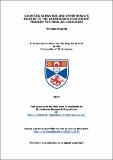Files in this item
Counting subwords and other results related to the generalised star-height problem for regular languages
Item metadata
| dc.contributor.advisor | Ruškuc, Nik | |
| dc.contributor.advisor | Roney-Dougal, Colva Mary | |
| dc.contributor.author | Bourne, Thomas | |
| dc.coverage.spatial | vii, 93 p. | en_US |
| dc.date.accessioned | 2017-11-07T14:16:13Z | |
| dc.date.available | 2017-11-07T14:16:13Z | |
| dc.date.issued | 2017-12-07 | |
| dc.identifier.uri | https://hdl.handle.net/10023/12024 | |
| dc.description.abstract | The Generalised Star-Height Problem is an open question in the field of formal language theory that concerns a measure of complexity on the class of regular languages; specifically, it asks whether or not there exists an algorithm to determine the generalised star-height of a given regular language. Rather surprisingly, it is not yet known whether there exists a regular language of generalised star-height greater than one. Motivated by a theorem of Thérien, we first take a combinatorial approach to the problem and consider the languages in which every word features a fixed contiguous subword an exact number of times. We show that these languages are all of generalised star-height zero. Similarly, we consider the languages in which every word features a fixed contiguous subword a prescribed number of times modulo a fixed number and show that these languages are all of generalised star-height at most one. Using these combinatorial results, we initiate work on identifying the generalised star-height of the languages that are recognised by finite semigroups. To do this, we establish the generalised star-height of languages recognised by Rees zero-matrix semigroups over nilpotent groups of classes zero and one before considering Rees zero-matrix semigroups over monogenic semigroups. Finally, we explore the generalised star-height of languages recognised by finite groups of a given order. We do this through the use of finite state automata and 'count arrows' to examine semidirect products of the form 𝐴 ⋊ ℤ[sub]𝑟, where 𝐴 is an abelian group and ℤ[sub]𝑟 is the cyclic group of order 𝑟. | en_US |
| dc.language.iso | en | en_US |
| dc.publisher | University of St Andrews | |
| dc.subject | Regular language | en_US |
| dc.subject | Generalised star-height | en_US |
| dc.subject | Semigroup | en_US |
| dc.subject | Monoid | en_US |
| dc.subject | Subwords | en_US |
| dc.subject.lcc | QA267.3B78 | |
| dc.subject.lcsh | Formal languages | en |
| dc.title | Counting subwords and other results related to the generalised star-height problem for regular languages | en_US |
| dc.type | Thesis | en_US |
| dc.contributor.sponsor | Engineering and Physical Sciences Research Council (EPSRC) | en_US |
| dc.type.qualificationlevel | Doctoral | en_US |
| dc.type.qualificationname | PhD Doctor of Philosophy | en_US |
| dc.publisher.institution | The University of St Andrews | en_US |
This item appears in the following Collection(s)
Items in the St Andrews Research Repository are protected by copyright, with all rights reserved, unless otherwise indicated.

